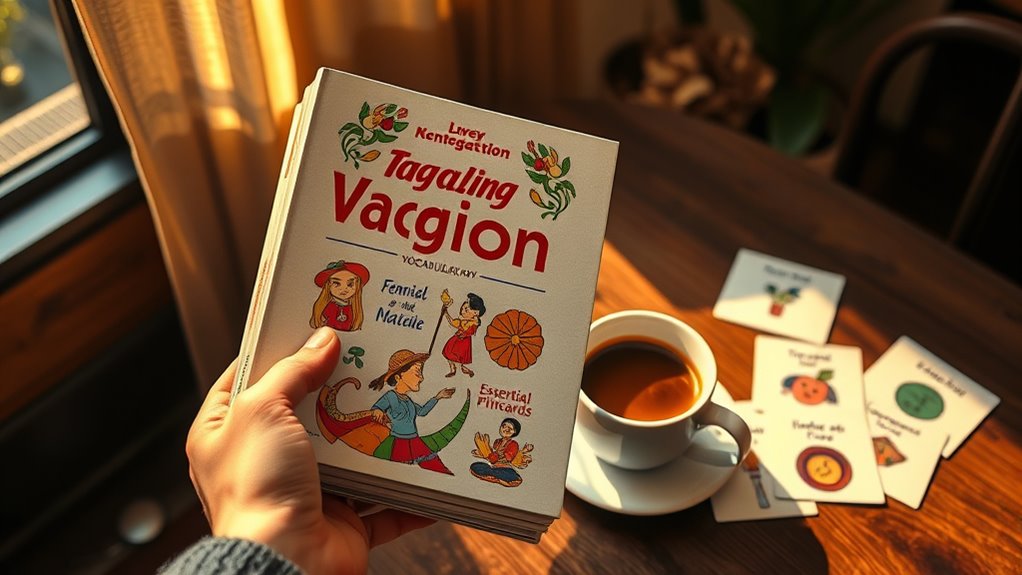To learn basic Tagalog for your Filipina relationship, start with essential phrases for everyday chats, like greetings and expressions of gratitude. Focus on pronunciation by practicing vowel sounds and listening to native speakers. Immerse yourself in Filipino culture through family events and local traditions, which can enrich your learning experience. Build your vocabulary with flashcards and Tagalog media. As you grow in language skills, you’ll discover even deeper ways to connect with your partner.
Key Takeaways
- Start with essential phrases for daily conversations to enhance communication and emotional intimacy in your relationship.
- Practice pronunciation by focusing on vowel sounds and listening to native speakers for better understanding.
- Engage with Filipino culture by participating in family activities and traditions to build trust and connection.
- Use flashcards and apps to expand your vocabulary, making it easier to incorporate Tagalog into your conversations.
- Immerse yourself in Tagalog media, such as music and podcasts, to familiarize yourself with the language contextually.
Importance of Learning Tagalog in a Relationship

Learning Tagalog can greatly enhance your relationship, especially if your partner comes from a Filipino background. By learning the language, you’ll deepen your cultural appreciation and better understand their traditions. This effort shows respect for their heritage, strengthening your bond through shared experiences.
Engaging with their family and community becomes easier, making those connections more meaningful.
Furthermore, learning Tagalog minimizes misunderstandings, allowing you to express your emotions accurately and fostering emotional intimacy. This openness in communication improves your relationship dynamics.
Your commitment to learning the language builds trust and mutual respect, reinforcing your connection. Embracing this challenge together creates a supportive environment where both of you feel valued, enhancing your relationship’s overall strength and resilience.
Essential Phrases for Everyday Conversations

Mastering a few essential phrases can greatly enhance your ability to engage in everyday conversations in Tagalog. Start with greetings like “Magandang umaga” for “Good morning” and “Kumusta ka?” to ask, “How are you?”
When introducing yourself, use “Ano ang pangálan mo?” to ask for names and say “Kinagagalak kong makilala ka” when meeting someone new. Show gratitude with “Salamat” or “Maraming salamat po” for “Thank you very much.”
When asking questions, phrases like “Ano itô?” (What is this?) and “Saan ka pupuntá?” (Where are you going?) are helpful. Finally, express understanding with “Oo” for “Yes” and “Hindi” for “No.”
These phrases will make your conversations more enjoyable and meaningful.
Pronunciation Tips for Effective Communication

Engaging in conversations in Tagalog not only requires knowing phrases but also understanding how to pronounce them correctly. Focus on the five vowel sounds: /a/, /e/, /i/, /o/, and /u/. Familiarize yourself with the International Phonetic Alphabet (IPA) to grasp sound production better.
Practice consonant clusters like “tr,” “kr,” and “gr” to enhance your fluency. Listen to native speakers and mimic their pronunciation and intonation. Record yourself speaking and compare it with native examples to pinpoint areas for improvement.
Utilize resources like Filipino music and podcasts to get accustomed to natural sounds. Regularly interacting with native speakers will refine your skills and boost your confidence in effective communication.
Engaging With Filipino Culture

While diving into the vibrant world of Filipino culture, you’ll discover that it’s rich with traditions, values, and communal bonds that shape everyday life.
Family plays a central role, with close ties and respect for elders deeply ingrained. You’ll find that hospitality is a cherished value, making guests feel genuinely welcome.
Engage in bayanihan, a spirit of community cooperation, which reflects the Filipino ethos. Meals often bring people together, especially during celebrations like fiestas and holidays.
The Christmas season, celebrated from September to December, features unique traditions like Simbang Gabi and Noche Buena. Participating in these festivities will help you appreciate the culture, allowing you to connect more deeply with your Filipina partner and her heritage.
Building Vocabulary for Deeper Connections

Understanding Filipino culture opens the door to meaningful interactions, and building your Tagalog vocabulary is key to forming deeper connections.
Start with the basics by using flashcards, placing Tagalog on one side and English on the other. Familiarize yourself with common nouns like fruits and household items; label these objects in your home to reinforce learning.
Immerse yourself in Tagalog media—watch movies with subtitles, listen to Filipino songs, or engage with podcasts to absorb vocabulary in context. Use apps like Turong Wika for structured lessons, and practice thematically to enhance retention.
Regularly review what you’ve learned, and try to incorporate new words into your daily conversations. This approach fosters deeper connections with your Filipina partner.
Practicing Tagalog With Your Partner

Practicing Tagalog with your partner can transform your learning experience into a fun and enriching journey. Engage in daily conversations using basic phrases like greetings and expressions of gratitude.
Watch Filipino movies or TV shows together to grasp cultural nuances. Switch roles where one of you teaches the other, fostering mutual understanding. Regular feedback sessions can help you improve pronunciation and grammar.
Set fun challenges, such as speaking only in Tagalog during meals or outings. Share personal stories in Tagalog to deepen your emotional connection.
Utilizing Learning Resources for Language Acquisition

To effectively learn basic Tagalog, you can tap into a variety of resources that cater to different learning styles and preferences.
Discover diverse resources to master basic Tagalog, tailored to various learning styles and preferences.
Online courses like FilipinoPod101 and LingoHut provide structured lessons for beginners, while Global Language Online Support System offers real-life context.
For text-based resources, consider “Teach Yourself Complete Filipino” or “Colloquial Filipino,” which focus on essential grammar and dialogue.
Enhance your pronunciation with Forvo and practice vocabulary through Tagalog Flashcards.
Engaging with multimedia resources such as YouTube channels and podcasts can improve your listening skills.
Finally, structured environments like Preply offer personalized tutoring to boost your conversational practice.
Explore these tools to build a solid foundation in Tagalog.
Understanding Filipino Customs and Traditions

Filipino customs and traditions reflect a rich tapestry of values and beliefs that shape daily life and social interactions. You’ll notice the deep respect for elders, as they’re regarded as family heads.
The “Bayanihan” spirit fosters community cooperation, reinforcing strong family bonds that often span multiple generations. Hospitality is paramount; you’ll find that guests are warmly welcomed and celebrated.
With around 90% of the population identifying as Christian, religious observances like Holy Week and Simbang Gabi are essential. During holidays, especially Christmas, the festivities last for months, featuring traditional foods and gift-giving.
Embrace these customs, like using respectful greetings and involving family in discussions, to strengthen your relationship and connect more meaningfully with your Filipina partner.
Advancing Your Tagalog Skills Over Time

Building on your understanding of Filipino customs and traditions can greatly enhance your journey in learning Tagalog.
To advance your skills, incorporate effective learning strategies like the Pimsleur Method for organic vocabulary growth. Use YouTube lessons, like Tagalog Time, for conversational practice and cultural insights. Don’t forget to engage with language apps like Duolingo for interactive sessions.
Focus on core vocabulary first, then explore grammar rules to understand sentence structures. Regular conversations with native speakers will boost your fluency and pronunciation.
Expand your skills by immersing yourself in Filipino media and participating in language exchange events. Finally, commit to a consistent study routine to guarantee steady progress and mastery over time.
Frequently Asked Questions
How Long Does It Take to Become Conversational in Tagalog?
To become conversational in Tagalog, you can expect to spend around 3-4 years with consistent daily study.
If you’re diving into full-time learning, you might reach intermediate proficiency in just 6-12 months.
Part-time learners dedicating an hour daily could take 1-2 years for the same level.
Are There Any Online Communities for Tagalog Learners?
If you’re enthusiastic to learn Tagalog, explore vibrant online communities!
You can join Reddit’s r/Tagalog for direct exchanges, participate in Facebook groups for collaboration, and engage in Discord servers for chat practice.
Language exchange websites like Tandem connect you with native speakers, while forums like Linguaholic foster discussions.
YouTube channels and podcasts offer additional multimedia resources, enriching your learning experience.
Immerse yourself, connect, and watch your skills flourish!
What’s the Best Way to Practice Speaking Tagalog Daily?
To practice speaking Tagalog daily, you should engage in conversations with native speakers or language partners.
Try using language exchange apps to find someone to chat with regularly.
Watching Tagalog shows or listening to podcasts can also enhance your speaking skills.
Don’t forget to sing along to Tagalog songs to improve your pronunciation.
Set aside time each day for these activities, and you’ll notice significant progress in your speaking ability!
How Can I Improve My Listening Skills in Tagalog?
To improve your listening skills in Tagalog, engage actively with audio materials.
Listen to podcasts and watch Filipino films with subtitles to familiarize yourself with different accents.
Take notes while listening, summarize afterward, and pause to reflect on what you’ve heard.
Discuss your insights with native speakers or language partners.
Finally, incorporate music and audiobooks to enhance vocabulary and pronunciation through repetitive listening, making the learning process enjoyable and effective.
Are There Tagalog Language Apps You Recommend for Beginners?
You’re enthusiastic to plunge into Tagalog, but where do you start?
For beginners, I recommend apps like Ling App, which makes learning fun with games and cultural insights.
Simply Learn Tagalog is great for essential phrases, while Drops uses visuals to keep you engaged.
EasyTagalog covers vocabulary and grammar effectively.
With these tools, you’ll build your language skills and open up a world of communication.
Get ready to explore!
Conclusion
Learning Tagalog isn’t just about picking up a language; it’s like planting a seed in your relationship that can blossom into a deeper connection. By embracing the language, you’re nurturing your bond and showing your commitment to understanding your partner’s culture. As you practice and grow together, you’ll discover new ways to communicate and connect. So, immerse yourself, explore the beauty of Tagalog, and watch your relationship flourish in ways you never imagined.









